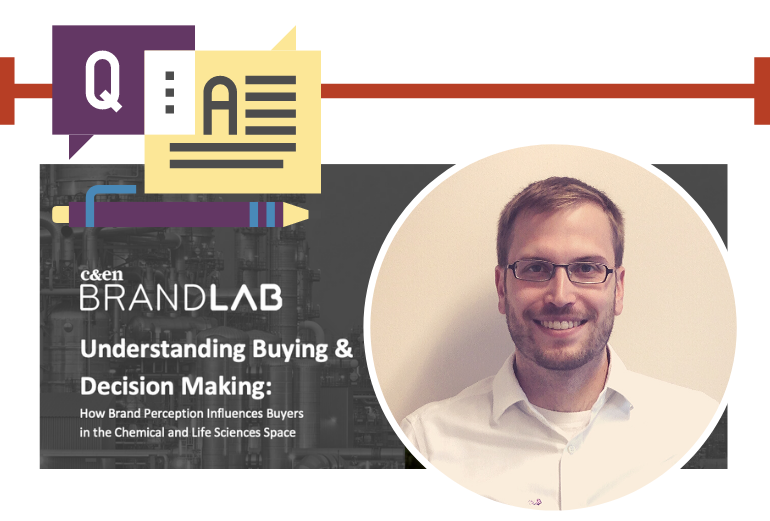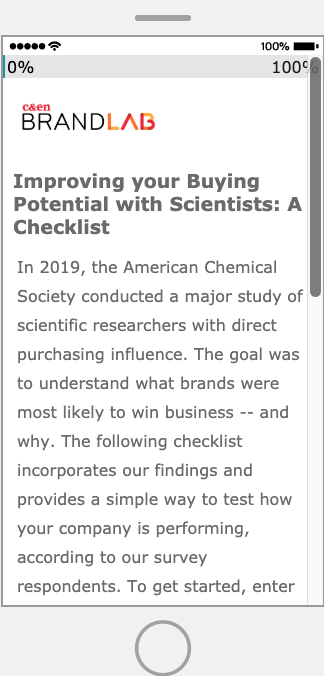Aaron Young is a researcher with over a decade of experience in data gathering and analysis, including leading a research division at Atlantic Media in Washington, D.C. that studied innovation within the advocacy and government affairs industry. Recently, Young worked closely with C&EN BrandLab to develop and deploy the recent brand study that analyzed perception and buying behavior, and sat down with us to talk through the methodology and what we learned.
How do we pinpoint the most vital elements of a brand that have a real impact on whether or not customers would purchase or recommend its products? That is the question a major study by C&EN BrandLab set out to answer with an in-depth analysis of key purchase drivers in the chemical and life sciences industry.
Working with researchers, the American Chemical Society and its custom content studio, C&EN BrandLab, we surveyed 779 scientists about their perceptions of 23 brands to find out what factors really mattered to them at the buying decision point. “These weren’t just random employees in a lab,” says Young. “Sixty-three percent of the respondents of this survey are involved in the final decision process, and collectively are responsible for over $150 million in potential buying power.”
The full results of the study have been synthesized in an on-demand webinar that walks the listener through the dynamics between brand perception and buying. The study was also used to create an interactive Brand Health Checklist companies can use to gain insights into what they are doing right – and where they have opportunities to grow.
Here, Young highlights some of the study’s key findings and breaks down what marketers can take away from it to drive sales.
What was this study’s biggest takeaway for marketers when it comes to driving sales?
We tested 14 of the key drivers that influence purchases and differentiated which ones matter and which ones really don’t. Far and away, we found that innovation is the most important driver for determining which products purchasers wanted to buy or were excited to try.
Data can tell you which factors matter and don’t matter to your customers
But we also found that simply appearing innovative wasn’t enough. Respondents were most favorable to products that weren’t just groundbreaking or disruptive, but also included key customer service elements where the brand offered to teach and show their customers how the product could transform their work.
While not the only piece of the puzzle, portraying your company as innovative is still a tall order. Did the study reveal how a company could prove that it’s dedicated to innovation in their marketing campaigns?
While the term thought-leadership can be overused, in this case, it is vital to brand perception. And especially in the chemical sciences, we see certain companies simply do a better job of creating substantive content that is unique and informative.
As part of our research, we examined ad spend against the sophistication of campaigns and the perception of thought leadership. As expected, we saw a match between those brands that invested in consistent content efforts and those that were top performers for buying and recommendation preference. Further, companies that devote time and energy to high-quality content received favorable ratings when our study asked, “This brand develops new products that I am excited to try in my lab” and “This brand teaches me about how product innovations will change my work.”
Professionals who have been at their craft for a long time are always curious about how their industry is changing, and it is a company’s responsibility to provide insights into how their innovative products are helping shape the future. That requires some investment in content creation and research.
Were there any surprising factors that drove purchasing decisions?
When we asked how likely respondents were to purchase a company’s product, very practical considerations factored highly. Respondents were likely to purchase from companies that lived up to statements like, “This brand makes it easy for me to purchase their products” and “This brand is helpful when I ask them how to use their products.” Customer service is clearly an essential part of decision making. And most vital is the company’s consistency. That was the number one factor when we asked what would make them want to recommend this brand to a colleague.
Usually if you ask anyone to guess what the number one factor would be, they would say cost. And here, they’d be wrong.
How should a science marketer use the Brand Health Checklist?
The Brand Health Checklist allows a company of any size to easily analyze its brand strength. The tool gives users a score and recommends action items to improve it. But to get the most of it, it’s important to be honest and open. Don’t do it in isolation either – bring in other voices. We recommend you have your entire team, or 10-15 people use the checklist, and then compare notes. Take an average of scores and see where you are. If you do it in isolation, there’s the danger that the results can be skewed by one person’s temperament. An overly optimistic person might be left thinking that everything is perfect while an overly pessimistic personality can be left feeling hopeless. Neither result is very helpful. The ultimate goal of the Brand Health Checklist is to identify those not-so-obvious areas where there is room for improvement.
Why is a study like this important for industry leaders?
No survey or amount of data can ever give a roadmap to guaranteed success, but research like this helps companies determine where it’s best to focus their attention. The word “brand” is a vague construct. It’s an umbrella of many factors. Data can tell you which factors matter and don’t matter to your customers, and that gives an organization more confidence in the investments they make, the messages they send and how they brand themselves to potential customers.
With this study, we set out to answer very important questions about these brands and what drives the decision to purchase and recommend them. The on-demand webinar that explains our findings is a great way to see what is top of mind for buyers industry-wide, and the online Brand Health Checklist is an easy way to determine the strengths and weaknesses of your specific brand’s perception.
By zeroing in on those key drivers that really matter to purchasers, brands will increase their ability to thrive and grow.
Was your company among the 25 brands that C&EN BrandLab studied? Contact us today at cenbrandlab@acs.org to find out how you can see your results, or schedule a survey of your own.



















